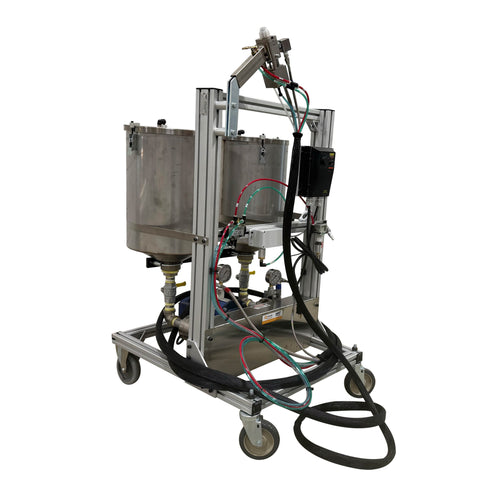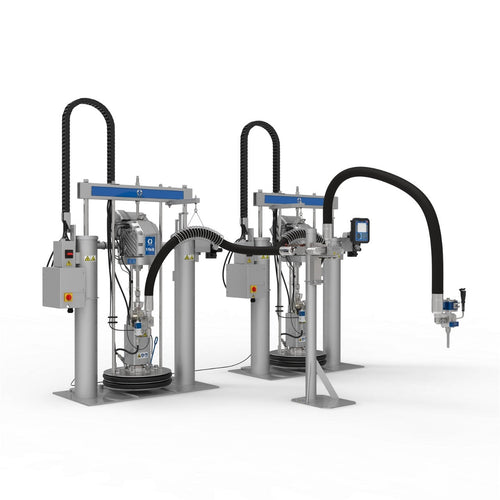Table of Contents:
- What Is In-Mold Coating?
- In-Mold Coating Materials
- How Does In-Mold Coating Work?
- Benefits of In-Mold Coating
- Equipment Recommendation
Consumers seek high-quality products that are both visually appealing and built to last. Companies prioritize efficient manufacturing processes that will save them time and money. In-mold coatings (IMC) are a solution that can often be used to satisfy both parties.
What Is In-Mold Coating?
In-mold coating (IMC) is a manufacturing process in which a specialized coating is applied directly within the mold itself during the molding process. During production, the coating material is injected into the mold and subsequently cured through a baking process. The result is a single, fully integrated finished product.
The in-mold coating process merges coating and molding into a single operation instead of having a separate coating process post-production. By eliminating an entire production step, in-mold coatings can streamline manufacturing, improve overall efficiency, and result in significant cost savings for manufacturers.
In-Mold Coating Materials
Within the industry, in-mold coating materials are sometimes informally referred to as "paint" and serve both aesthetic and functional purposes. They can provide protection from scratches, chemicals, UV radiation, weather, and more depending on the specific formulation. Some in-mold coating materials are even engineered with special properties such as electrical conductivity, soft-touch finishes, or integrated primer and topcoat systems.
With so many different properties, there are numerous applications for in-mold coatings. Some common applications include use with automotive body parts, boat hulls, and semitruck body parts.
Currently, Sherwin-Williams® and OMNOVA® are the two primary manufacturers in the in-mold coatings market. Both of these in-mold coating supplies carry options that have different properties and can service different industries. The Polane® IMC Blade Coat from Sherwin-Williams, for example, is specifically designed for wind turbines. Also, OMNOVA has a heat-activated IMC known as GENGLAZE™ EC-2447 that is often used in automotive parts. Selecting the appropriate IMC formulation for your application depends on factors like the end-use application and the substrate material.
How Does In-Mold Coating Work?
In a simplified manner, the steps for in-mold coating are as follows:
-
Mold Preparation: The mold is cleaned and prepped as needed. In some cases, this step may include the application of a release agent or primer.
-
SMC Molding: The sheet molding compound (SMC) is placed into the mold cavity in preparation for compression molding.
-
Compression & Heating: The mold is closed. Pressure and heat are applied for anywhere from 30 to 60 seconds to begin the curing process. The exact time will depend primarily on the size of the part.
-
Pressure Release: The tonnage of the mold is released to make space for the coating material.
-
Injection: The in-mold coating material is injected into the mold cavity.
-
Recompression: The mold is recompressed to full tonnage for a designated amount of time to allow the coating to bond with the part and cure.
-
Completion: The mold is opened, and the finished part is removed.
The entire process usually takes less than two minutes. Compared to conventional methods that require a separate coating step, this integrated approach can significantly reduce cycle time. As a result, manufacturers may benefit from increased production speed, higher throughput, and improved operational efficiency.
Benefits of In-Mold Coating
In-mold coatings are gaining widespread popularity because of their numerous advantages. Our team shares some of the key benefits of in-mold coatings below.
Increased Efficiency
By integrating the coating application directly into the molding process, IMC eliminates the need for a separate coating/painting process. This combination can speed up the manufacturing process and increase production for improved overall efficiency.
Cost Savings
Along with improving efficiency, the in-mold coating process can also lead to substantial cost savings for businesses. It can reduce or eliminate manufacturing steps, equipment requirements, or labor costs. In the long run, this streamlined approach can save businesses a significant amount of money.
Improved Durability
In-mold coatings offer multiple functional benefits to improve durability and increase the lifespan of the components they are added to. They can fill micro-voids and surface porosity in composite parts to create a smoother, more uniform surface. Additionally, they can provide a protective layer to increase resistance to moisture, corrosion, UV radiation, discoloration, certain chemicals, and more.
Aesthetic Finish
In-mold coatings not only enhance durability, but also they can improve the aesthetic quality of the finished product. They can create a clean, homogenous surface that can decrease the instances of surface defects. They can also reduce or eliminate fiber read-through, prevent orange peel, and enhance DOI. Altogether, the finished product achieves a polished, high-quality appearance that meets professional standards.
Potential Environmental Benefits
Another benefit of in-mold coatings is that they may be able to lower volatile organic compound (VOC) emissions, especially in comparison to conventional painting methods. This factor alone can be beneficial for the environment, but by eliminating additional coating application steps, IMC may also reduce energy consumption and decrease waste in the manufacturing process.
Get the Right Equipment
If you are ready to implement in-mold coating for sheet molding compound (SMC) compression molding operations into your production process, the next step is selecting the right equipment. Our team recommends the AS365 in-mold coating equipment.
There are several great properties and benefits of the AS365 in-mold coating equipment including:
-
Easy Configuration & Integration: This machine is engineered for seamless integration into your existing SMC molding process. It features an HMI electrical interface and includes a PLC to make it user-friendly even for people new to IMC.
-
Self-Contained & Portable Setup: Designed as a standalone unit, this equipment is fully integrated and mounted on a cart system for easy mobility and flexible deployment across your facility.
-
Cost-Effective Solution: Along with being a long-term cost savings solution, this system is also the only one of its kind available in North America. While similar equipment exists in Europe, sourcing from overseas often leads to higher costs, quality issues, and logistical problems.
-
Precision Metering: Equipped with linear transducer technology, this system ensures accurate volume measurement and precise shot size control to enhance consistency and product quality.
-
Versatile Configurations: The system also supports multiple metering and capacity configurations so it can adapt to a wide range of production requirements.
Take the Next Step
These coatings are more than just a protective measure. They offer businesses the opportunity to enhance their manufacturing efficiency and save money. If you are looking to incorporate in-mold coating into your manufacturing processes, we may be able to help. Contact us to speak with an expert about the equipment we have available as well as your dispensing system integration.








